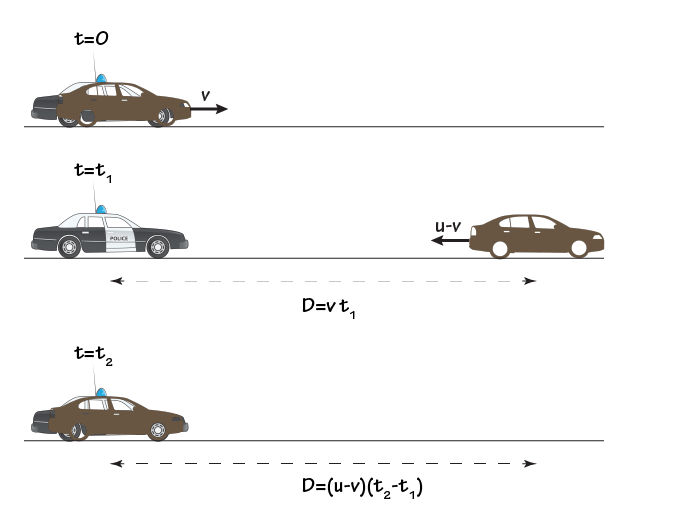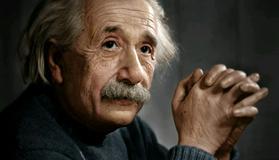Physics Primer
物理入门
Moving reference frames
移动参照物
In the following lessons we will often talkabout what observers in different frames of reference experience. We will callthe rest frame of an observer the reference frame in which the observer is notmoving. Imagine you are seated in a moving train – the train would be your restframe, and the station would be moving with respect to you.
在下面的课程中,我们将经常讨论不同参照系中的观察者的经验。我们将把观测者的静止框架称为观察者不移动的参考框架。想象一下你坐在一列移动的火车上——火车是你的休息架,车站会向你移动。
If you find it hard to believe that anyonemight think that the station is moving, you could also imagine two trainsmoving parallel to each other with constant velocity. If you are seated in ofthese trains and look at the other train (while ignoring the surroundings) youwill be under the impression that the other train is moving. There are noexperiments you could observe in either of the two trains that could make youdecide which train is “really” moving.
如果你发现很难相信有人会认为火车站在移动,你也可以想象两列火车以恒定的速度彼此平行地移动。如果你坐在这些列车上,看着另一列火车(忽略周围的环境),你会觉得另一列火车在移动。在这两列火车中,没有一个实验能让你决定哪一列火车是“真正”的在移动。
Though motion is relative, the laws ofphysics are not! While you and a colleague of yours in the opposite traincannot agree about which train is moving, you should always be able to agreeabout the results of experiments and the laws you establish. Furthermore, ifyou carry an experiment in your train (i.e. in your rest frame) you should beable to infer how the colleague in the opposite train would perceive yourexperiment.
虽然运动是相对的,但物理定律不是!当你和你的另一个同伴在火车上不同意哪一列火车在移动时,你应该总是能够同意你所建立的实验结果和法律。此外,如果你在你的列车上进行试验(即在你的休息架上),你应该能够推断出对面火车上的同事是如何看待你的实验的。
Let’s look at an example:
让我们看一个例子:

1. An observer O sees a train pass by withconstant velocity v. In the train there are an observer O′ and a basketball that are also moving with velocity v (as measuredby the observer O). Based on this information, the observer O can conclude thatthe observer O′ and the basketball areat rest in the train.
1。观察者看到火车在火车上以恒定的速度通过,有一个观察者O和一个篮球,也随着速度v移动(如观察者O′所测量)。根据这些信息,观察者O′可以得出结论:观察者O′和篮球在火车上休息。
2. For the observer O′ the basketball is at rest, and the station is moving with velocity −v.Based on this information, the observer O′ can conclude that for the observer O the basketball is moving withvelocity v.
2。为观察O′篮球是在休息,和车站与速度−V.基于这一信息运动,观察者O′可以得出这样的结论:观察者的速度v的运动是篮球
3. If the observer O would see thebasketball moving with velocity v+u and the train with velocity v, he couldconclude that the ball is moving with velocity u in the rest frame of theobserver O′.
3。如果观察者看到篮球运动的速度v + u和列车速度V,他可以得出结论,球是移动的速度u在休息帧的观察员O '。

Racing on the Highway (Police car restframe)
在高速公路上比赛(警车休息架)
Let's have another look at the Racing onthe Highway problem, but this time by looking at it from the perspective of thepolice car. This was the premise of the problem: a racing car moves with aspeed v and passes by a police car at the time t=0. The police car startsmoving with the speed u at a time t=t1 and it reaches the racing car at thetime t=t2. Let's translate this in the rest frame of the police car:
让我们再看一看高速公路上的赛车问题,但这次是从警车的角度看的。这是问题的前提:一辆赛车以一个速度v移动,在一辆警车通过时T=0。警车开始时以U为单位移动,在时间t=T2时到达赛车。让我们在警车的其他框架里翻译这个:

1. The racing car passes by thepolice car with a speed v at the time t=0.
1。赛车在时速为0时以速度V通过警车。
2. At the time t=t1 the racingcar suddenly starts moving back towards the police car with velocity u−v. Thedistance covered by the racing car from the time t=0 to t=t1 is D=v⋅t1.
2。在时间t = T1赛车突然开始回归速度U−V的距离从时间t = 0到T = T1是D=v⋅t1的赛车上警车。
3. At the time t=t2 the racingcar reaches the police car. The racing car has moved over the distance D with aspeed u−v in the time t2−t1 so
3.在比赛的时候,赛车到达警车。赛车已经在距离和速度u−V在时间T2−T1,所以

If we rearrange the terms we get:
如果我们重新排列我们得到的条件:




